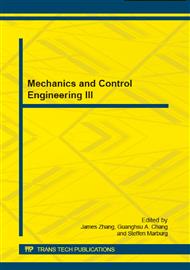[1]
B. Yu, M. Liu, P. Egolf, A. Kitanovski: A review of magnetic refrigerator and heat pump prototypes built before the year 2010, international journal of refrigeration 33, 6, 1029-1060. (2010).
DOI: 10.1016/j.ijrefrig.2010.04.002
Google Scholar
[2]
B. Yu, Q. Gao, B. Zhang, X. Meng, Z. Chen: Review on research of room temperature magnetic refrigeration, International journal refrigeration 26, 6, 622 - 636. (2003).
DOI: 10.1016/s0140-7007(03)00048-3
Google Scholar
[3]
G. Brown: Magnetic heat pumping near room temperature, Journal of application Physics 47, 8, 3673-3680. (1976).
DOI: 10.1063/1.323176
Google Scholar
[4]
G. Brown: Magnetic stirling cycles-A new application for magnetic materials, Magnetics, IEEE Transactions on 13, 5, 1146-1148. (1977).
DOI: 10.1109/tmag.1977.1059542
Google Scholar
[5]
J. Organ. The air engine stirling cycle power for a sustainable future. CRC Press, Wood head Publishing in Mechanical Engineering, (2007).
Google Scholar
[6]
J.H. Huang, J.R. Liu, P.Y. Jin, H.W. Yan, J.F. Qiu, L.Z. Xu, J.X. Zhang: Development of permanent magnetic refrigerator at room temperature, Rare Metals 25, 6, 641-644. (2006).
DOI: 10.1016/s1001-0521(07)60164-8
Google Scholar
[7]
Coelho, S. Gama, A. Magnus, G. Carvalho: Prototype of a Gd-based rotaring magnetic refrigerator for work around room temperature. In: Proceedings of the Third International Conference on Magnetic Refrigeration at Room Temperature, Des Moines, lowa, USA, 11-15 May. International Institute of Refrigeration, Paris, pp.381-386. (2009).
DOI: 10.1016/j.ijrefrig.2009.11.001
Google Scholar
[8]
C. Vasile, C. Mȕller: Innovative design of a magnetocaloricsystem, International Journal of Refrigeration 29, 8, 1318-1326. (2006).
Google Scholar
[9]
M. Liu, F. Yu: Theoretical and numerical investigations on refrigeration performance of irreversible regenerative magnetic brayton cycle, Journal of Xi'an Jiaotong University 44, 4. (2010).
Google Scholar
[10]
B. Neese, B. Chu, S. Lu, Y. Wang, E. Furman, M. Zhang: Large electrocaloric effect in ferroelectric polymers near room temperature, Science 321, 5890, 821-823. (2008).
DOI: 10.1126/science.1159655
Google Scholar


